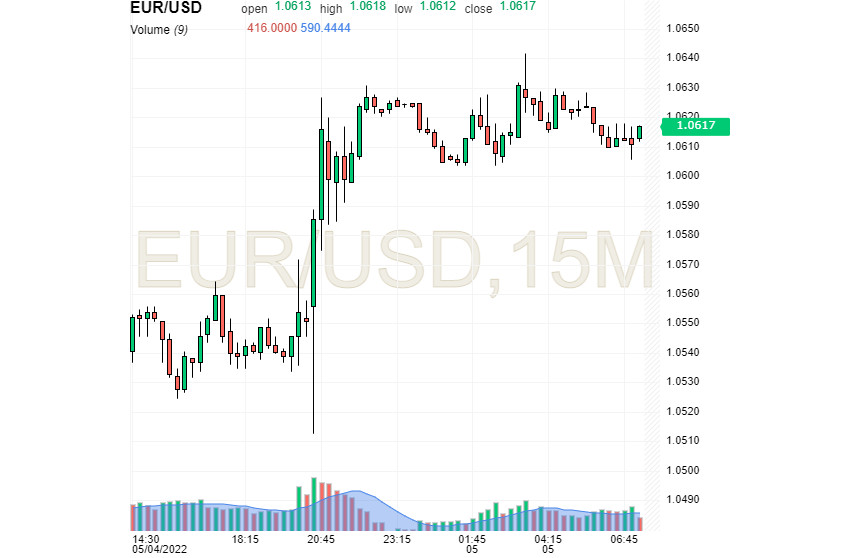
The US currency sank significantly after the Federal Reserve meeting. Recall that the central bank decided to increase the rate by 0.50%. This measure is a record step over the past 22 years.
On Wednesday evening, May 4, following the results of the Fed meeting, the US central bank announced an increase in the federal funds rate by 50 basis points (bp), to the range of 0.75%-1.00%. This decision, approved by the Federal Open Market Committee (FOMC), confirmed the market's expectations.
According to the plan, the Fed's current balance of $8.9 trillion will begin to shrink from June 1 this year. In the future, the volume of bonds held by the central bank should decrease monthly by $30 and $17.5 billion in June, July and August. After starting this program, the pace of reduction will accelerate. Over the next few years, the balance of assets may decrease by $3 trillion, experts believe.
Presumably, by the end of June 2022, the Fed's balance sheet will "lose weight" by $47.5 billion, but within three months sales of government securities will increase (up to $60 billion of treasury bonds and $35 billion of mortgage securities). It is expected that the amount of monthly asset sales on the central bank's balance sheet will increase to $95 billion.
The current situation did a disservice to the dollar, which sank sharply. And so the euro seized the initiative, which took over the reins of government. The European currency took advantage of the dollar's weakness and sharply rose. On the morning of Thursday, May 5, the EUR/USD pair was near 1.0617, winning back previous losses.

According to analysts, the weakening of the USD, which looked very "overheated" before the Fed meeting, is due to three reasons:
1) The Fed's refusal to aggressively raise the rate immediately by 75 bps. Note that experts estimated the probability of such an event at 20%.
2) Market expectations regarding the reduction of the central bank's balance sheet (market participants expected it to be reduced by $95 billion monthly, and the Fed offers a three-month acceleration to such a volume).
3) Market uncertainty regarding specific indicators of rate cuts. Recall that market expectations implied that the federal funds rate would increase either by 50 bps or by 75 bps in June. However, at a press conference held following the FOMC meeting, Fed Chairman Jerome Powell noted that the central bank plans to discuss raising rates on 50 bp at the next meetings.
After the press conference, it became clear to Powell that the futures market for the federal funds rate for June provides a range of up to 1.25%-1.5% per annum. At the same time, the target range of federal funds rates was 0.75%-1.0%. According to analysts, the current measures of the central bank are aimed at combating inflation, which has peaked over the past 40 years (+8.5% per annum in March 2022).
Following the results of the Fed meeting, the yields of 2-year US Treasury bonds, which are most sensitive to the dynamics of interest rates, fell to 2.6% from the previous 2.8%. At the same time, the yield on 10-year Treasury bonds sank to 2.91% from the previous 2.96%.
In general, the US stock market reacted positively to the Fed's decision on the rate. However, there is a minor setback: the greenback was seriously affected by lower yields and increased risk appetite. At the same time, traders preferred to take profits on long positions in the US currency.
Currently, the Fed is pursuing an aggressive strategy aimed at tightening the monetary policy. The central bank is rapidly curtailing programs to stimulate the national economy, which provoked an increase in inflationary pressure. At the same time, the Fed draws attention to the decline in the unemployment rate in the United States and the gradual "taxiing" of the American economy on a growth trajectory.
Excessively aggressive actions of the Fed are appropriate to curb galloping inflation. However, many believe that the central bank was too late with tightening, and now it needs to tighten the screws in the economy more. Such measures undermine the greenback, which has to surrender to the mercy of the winner in the person of the Fed. Along with this, experts fear a potential strengthening of the USD in the near future. According to preliminary estimates, this will worsen the conditions for the sale of US government bonds and will become an additional source of stress for the financial system.
 English
English 
 Русский
Русский Bahasa Indonesia
Bahasa Indonesia Bahasa Malay
Bahasa Malay ไทย
ไทย Español
Español Deutsch
Deutsch Български
Български Français
Français Tiếng Việt
Tiếng Việt 中文
中文 বাংলা
বাংলা हिन्दी
हिन्दी Čeština
Čeština Українська
Українська Română
Română

